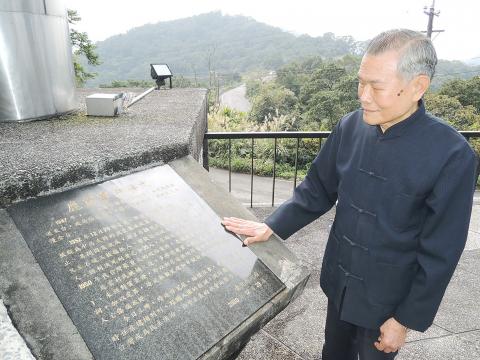An 80-year-old who was falsely imprisoned following the 1952 Luku Incident (鹿窟事件) has published a memoir of the dark chapter in the White Terror era on a bid to do justice to history and commemorate others caught up in the events.
The Luku Incident began with a four-month military campaign to uncover and arrest alleged “communists” said to be operating in the mountainous areas around Luku Village, which borders now-New Taipei City’s Sijhih (汐止) and Shiding (石碇) districts. The action saw 35 people sentenced to death and 98 imprisoned, making it one of the harshest episodes of suppression during the White Terror era.
Lee Shih-Cheng (李石城), the author of the memoir, also financed the building of a memorial column at Sijhih’s Daqijiao (大崎腳) in 2000 to commemorate an uprising organized by a group of townspeople, including his father, against the Japanese colonial government more than 100 years ago, he said.

Photo: Weng Yu-huang, Taipei Times
The resistance, composed of a group of untrained and insufficiently armed citizens, was met by a superior Japanese force, resulting in heavy causalities, with 99 people killed at Daqijiao. The Japanese government branded those involved in the uprising “bandits,” a stigmatizing term Lee aimed to correct by establishing the column.
He was also called a “communist bandit” when he was 17 and served 10 years in prison following the Luku Incident, he said.
Lee was born to poor farmers in Sijhih and he received only two years elementary education before leaving to work on the family farm, he said.
He was underage when he was recruited by villagers, including a distant relative of his, into an armed group active in the mountains around Luku Village, he said.
He became a member of the group’s “youth vanguard,” but he did not do anything illegal and received no financial benefit, he said, adding that he only offered the group friendly support.
However, government forces laid siege to Luku and the surrounding areas in December 1952 to crack down on what they termed “a communist rebellion,” and more than 200 people were arrested, interrogated and tortured, he said.
Lee suffered spinal injuries and lost his teeth under torture, but he denied any involvement in the so-called rebellion, knowing that an admission of guilt meant certain death, he said.
“I escaped death but not a prison term,” he said.
He was given a 10-year sentence for his “involvement in a communist organization and attempt to overthrow the government,” he said
The court commuted the sentence to five years as Lee was only 17, but he was not released until he was 28 — after having served the full 10 years, he said.
His mother died shortly after he was imprisoned, but he did not find out until after his release, he said.
He was originally denied employment as his identification card indicated that he was restricted from military service — usually signifying a criminal record — but a fellow villager later gave him a mining job, he said.
Having survived hard times, he went on to father a family of five, and his children are all doing well, he said.
He wrote his memoir to document the injustices of the White Terror era and pay tribute to his fellow victims, he said, adding that he taught himself to read and write during his imprisonment.
He said that history must not be forgotten so people do not make the same mistakes, and that he had learned to let go of the bitterness and resentment.

A strong continental cold air mass is to bring pollutants to Taiwan from tomorrow, the Ministry of Environment said today, as it issued an “orange” air quality alert for most of the country. All of Taiwan except for Hualien and Taitung counties is to be under an “orange” air quality alert tomorrow, indicating air quality that is unhealthy for sensitive groups. In China, areas from Shandong to Shanghai have been enveloped in haze since Saturday, the ministry said in a news release. Yesterday, hourly concentrations of PM2.5 in these areas ranged from 65 to 160 micrograms per cubic meter (mg/m³), and pollutants were

Taiwan’s armed forces have established response protocols for a wide range of sudden contingencies, including the “Wan Chun Plan” to protect the head of state, the Ministry of Defense (MND) said today. After US President Donald Trump on Saturday launched a series of airstrikes in Venezuela and kidnapped Venezuelan President Nicolas Maduro, concerns have been raised as to whether China would launch a similar “decapitation strike” on Taiwan. The armed forces regularly coordinate with relevant agencies and practice drills to ensure preparedness for a wide range of scenarios, Vice Minister of National Defense Hsu Szu-chien (徐斯儉) told reporters before a

EVA Airways on Saturday said that it had suspended a pilot and opened an investigation after he allegedly lost his temper and punched the first officer several times as their plane was taxiing before takeoff at Los Angeles International Airport. According to a report published on Thursday by The Reporter, the incident occurred after the flight’s Malaysian first officer tried to warn the Taiwanese pilot, surnamed Wen (文), that he was taxiing faster than the speed limit of 30 knots (55.6kph). After alerting the pilot several times without response, the first officer manually applied the brakes in accordance with standard operating

NOT AN OPENING: Trump’s violation of international law does not affect China’s consideration in attacking Taiwan; Beijing lacks capability, not precedent, an official said Taiwanese officials see the US’ capture of the president of Venezuela as a powerful deterrent to Beijing’s aggression and a timely reminder of the US’ ability to defeat militaries equipped with Chinese-made weapons. The strikes that toppled Venezuelan President Nicolas Maduro signaled to authoritarian leaders, including Chinese President Xi Jinping (習近平), US President Donald Trump’s willingness to use military might for international affairs core to US interests, one senior official in Taipei’s security circle said. That reassured Taiwan, the person said. Taipei has also dismissed the idea that Trump’s apparent violation of international law could embolden Beijing, said the official, who was not